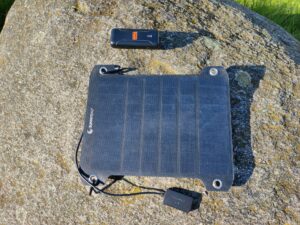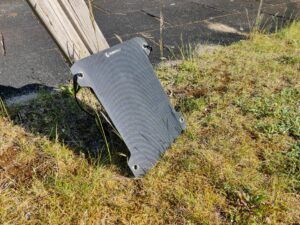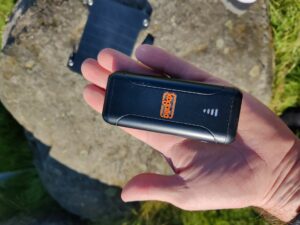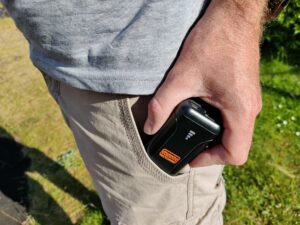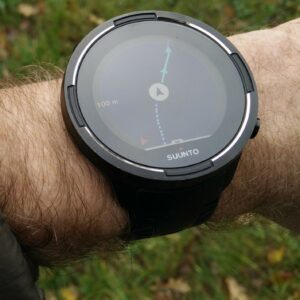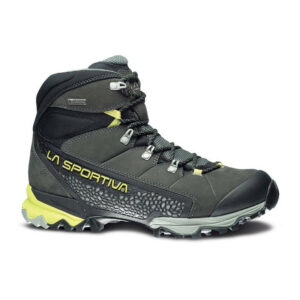Today most people take one or more electronic devices with them when they go backpacking. These devices typically have rechargeable batteries, and their batteries often don’t last for the duration of the whole trip. That’s especially true for smartphones, handheld GPS devices, GPS watches and headlamps. To recharge these devices, you’ll need a device that either stores energy or generates it from natural sources. The two most common devices that are used for charging devices on-the-go are power banks and solar chargers. Now, while the end result is the same with both devices, they do differ in terms of portability, weight, charging efficiency, versatility and more. In the following we’ll discuss how solar chargers compare to power banks. However, let’s first explain the basics of the two devices.
Table of Contents:
- The Basics of Power Banks and Solar Chargers
- Portability and Weight
- Charging Efficiency
- Versatility and Reliability
- Environmental Impact
- Price
- Conclusion
The Basics of Power Banks and Solar Chargers
A power bank is a portable device that stores electrical energy. In simple terms we could describe it as a powerful battery that can charge batteries of other electronic devices such as smartphones, tablets, cameras, GPS devices, headlamps, GPS watches etc. A power bank has a lithium-ion or lithium-polymer battery and one or more USB ports for charging other devices. It also has a USB port so it can be charged when its own battery runs out of power.
A solar charger, on the other hand, uses sunlight to generate electricity and charge devices directly or through an integrated battery pack. Solar chargers with integrated battery packs are not that common but the battery pack on such a solar charger is nothing else than a power bank attached to it. So, you might as well just buy a power bank in addition to solar charger instead of a solar charger with integrated battery pack.
Portability and Weight
Power banks are in general smaller and lighter than solar chargers. Therefore, they are easier to pack in a backpack and also easier to carry (you can read here why you should use lightweight gear for backpacking). However, the weight of a power bank depends on its battery capacity which is measured in milliamp hours. For example, the Goal Zero Flip 24 power bank has a battery capacity of only 6,700 milliamp hours and is therefore very light. It weighs 4.6 ounces (130 g). Nevertheless, such a power bank can’t even recharge Iphone 14 twice. More powerful power banks are much heavier. For example, the BioLite Charge 80 with the capacity of 20.000 milliamp hours weighs 1 lb. 6.4 oz. (620 g). Now, that’s more than what a compact solar charger weighs. For example, the Goal Zero Nomad 5 solar charger weighs only 12.7 oz (360 g).
Charging Efficiency
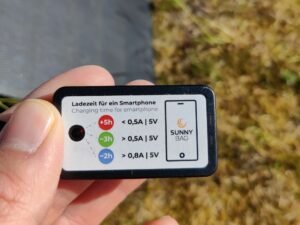
Solar charger’s efficiency depends on many factors such as strength of the sun, angle, technology etc.
Power banks have a high charging efficiency. When you connect your device to a power bank, the power bank provides a stable and consistent charging current thus ensuring fast charging. The charging speed varies depending on the power bank’s technology but if you buy a high-quality power bank it’ll for sure charge your devices fast.
The charging speed of a solar charger is influenced by various factors such as quality and efficiency of the photovoltaic cells, intensity of sunlight and position (angle). Now, solar chargers have advanced drastically in terms of technology in the last years. Nevertheless, they still don’t match power banks when it comes to charging efficiency.
One thing you should consider is that a solar charger might not generate any energy in bad weather which renders it pretty much useless if the sun doesn’t penetrate the cloud cover during your trip. Therefore, I do recommend also bringing a power bank.
Versatility and Reliability
Power banks are indeed more versatile than solar chargers. A power bank can be used not only when you’re backpacking but also when you’re travelling, commuting or simply need an emergency power source. Their charging performance is also not dependent on external factors such as sunlight. Therefore, power banks are a clear winner in terms of versatility and reliability.
However, one thing you should keep in mind is that a power bank is only deadweight when it’s empty. So, for very long backpacking trips it must be paired with a solar charger because no power bank can store an unlimited amount of energy.
Environmental Impact
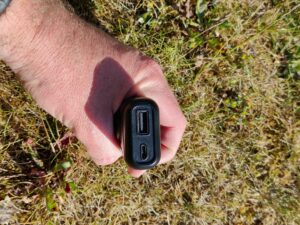
Power banks rely on conventional electrical energy sources which means they indirectly contribute to carbon emissions
Power banks rely on conventional electrical energy sources which means they indirectly contribute to carbon emissions and environmental pollution associated with the generation of electricity. The impact depends on where you live. If most of the electricity in your area comes from renewable sources the impact is small. However, if electricity is produced from fossil fuels that’s a different story. Solar chargers use the power of sunlight and are thus much cleaner.
However, the disposal of both power banks and solar chargers has environmental implications. Therefore, it’s important that you follow the disposal guidelines if these devices break down.
Price
The price depends on the brand, technology, quality and capacity (power banks). Power banks are in general less expensive than solar chargers. They retail for as little as $ 30. However, that’s not the case for power banks with big battery storage capacities. These are quite pricey. For example, the Goal Zero Venture 75 with the capacity for 20.000 milliamp hours costs no less than $ 120. The prices for quality solar chargers start at $ 60. However, top-notch models can cost as much as $ 200.
The prices for both solar chargers and power banks vary a lot. High-quality products are much more expensive than budget products.
Conclusion
So, should you buy a solar charger or a power bank? Well, there is no clear winner because it mostly depends on the type of your backpacking trips and electronic devices you bring with you. If you mostly do short outings or don’t have that many electronic devices a power bank is the obvious choice because it stores enough energy to power your devices for the duration of the trip. If you need more energy or do longer trips a solar charger is a better option because it theoretically has an unlimited supply of electricity. However, you might want to pair a solar charger with a power bank so that you also have access to electricity in cloudy or rainy weather.
I’d love to hear about your thoughts on power banks and solar chargers. Write them in the comments section below.
